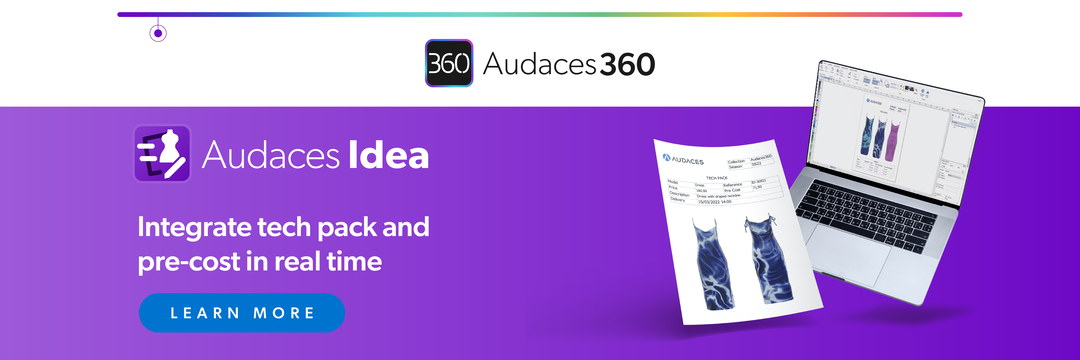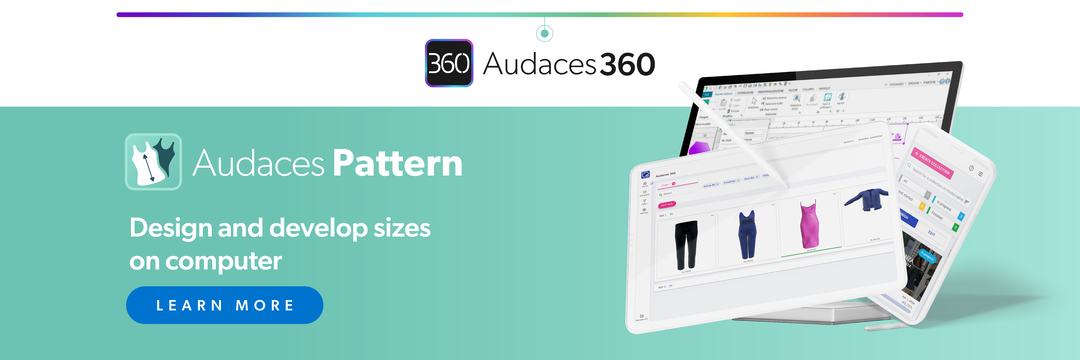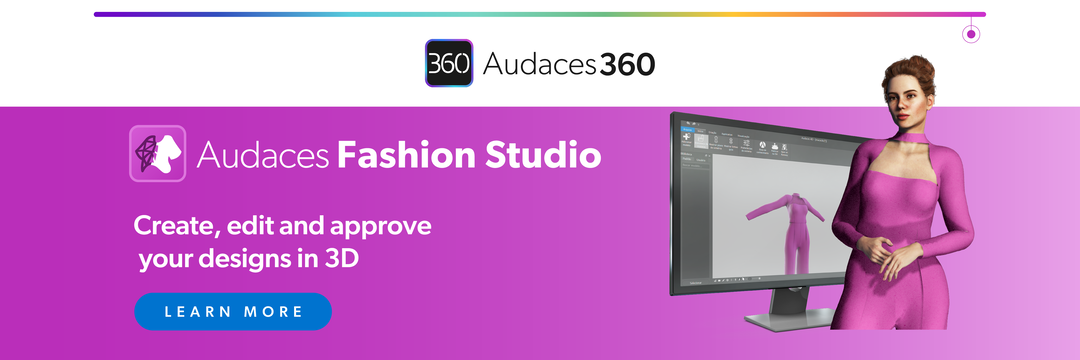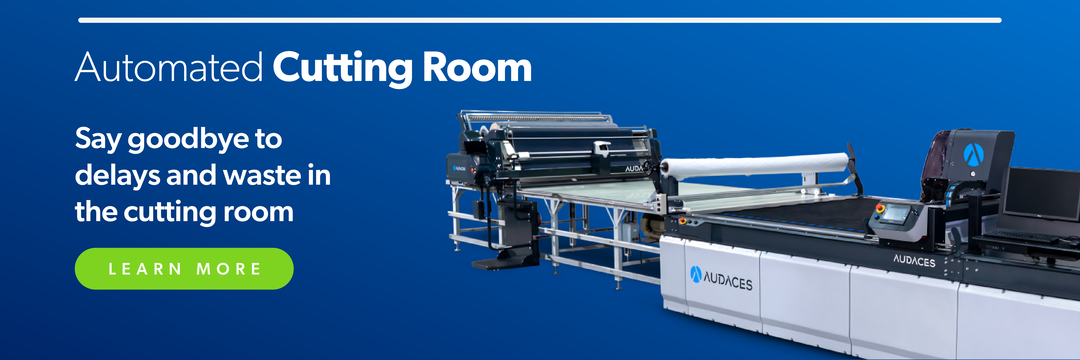Summary
- Flat pattern making is one of the most important steps in transforming a design into a finished garment.
- It gives structure to creative ideas and helps bring them to life with precision.
- Experience the future of the fashion industry with Audaces360. Start your free trial today!
Flat pattern making is a method for creating patterns using body measurements and basic shapes. From these, it’s possible to develop many different styles. It’s a way to turn imagination into something real.
For pattern makers, it’s a daily tool. It allows for better control of fit, shape, and proportion. I, fact, without it clothing production would lack consistency and quality.
In the next sections, you will find what you need to understand how flat pattern making works. You will learn about the tools you need and how to start or improve your skills.
Happy reading!
Sumário
What is the importance of flat pattern making in fashion?
Flat pattern making is one of the most important parts of creating clothes. It helps turn a sketch or idea into a real garment. Without it, fashion would not be so precise or professional.
This method lets you create shapes that fit the body well. When patterns are well-made, the result is a garment with proper fit. That makes clothes more comfortable and better-looking.
It gives you control over every detail of the garment. You can change necklines, sleeves, or shapes easily, gaining a powerful tool for both creativity and quality.
In short, flat pattern making helps brands bring ideas to life in a smart, accurate, and cost-effective way.
Learn more: Explore clothing pattern making techniques for your production
What is flat pattern making?
Flat pattern making is the process of creating clothing patterns on a flat surface. These patterns are useful to cut fabric and sew garments, starting from a set of body measurements included in the tech pack.
The process begins with a basic pattern, also called a block. This is a simple shape that fits the body with no style. It serves as a base for creating many other styles.
From the block, you can make a design pattern. This means changing the basic shape to match a fashion idea. You can add flare, change the neckline, or adjust the fit, for example.
You can perform flat pattern making on paper or with digital tools. Either way, the goal is the same: create clear and clean shapes to use in production.
Learn more: 6 pattern making tools every fashion designer should use
Most used types of flat pattern making by pattern makers
Flat pattern making starts with basic blocks. Each one of them is exclusive for a specific part of the body, like the bodice, pants, or sleeve.
Below are the most common types. Check it out:
Basic bodice block
The basic bodice block is one of the most important tools in pattern making. It covers the upper body from the shoulders to the waist. It has no style—it is plain and fitted.
Pattern makers use it to create tops, blouses, jackets, and dresses. It shows the right position of the bust, waist, and shoulder lines. With it, you can make many designs just by changing the shape or adding details.
Once you have a good bodice block, it becomes the base for many different styles. You can adjust it for comfort, shape, or design as many times as you want.
Basic pants block
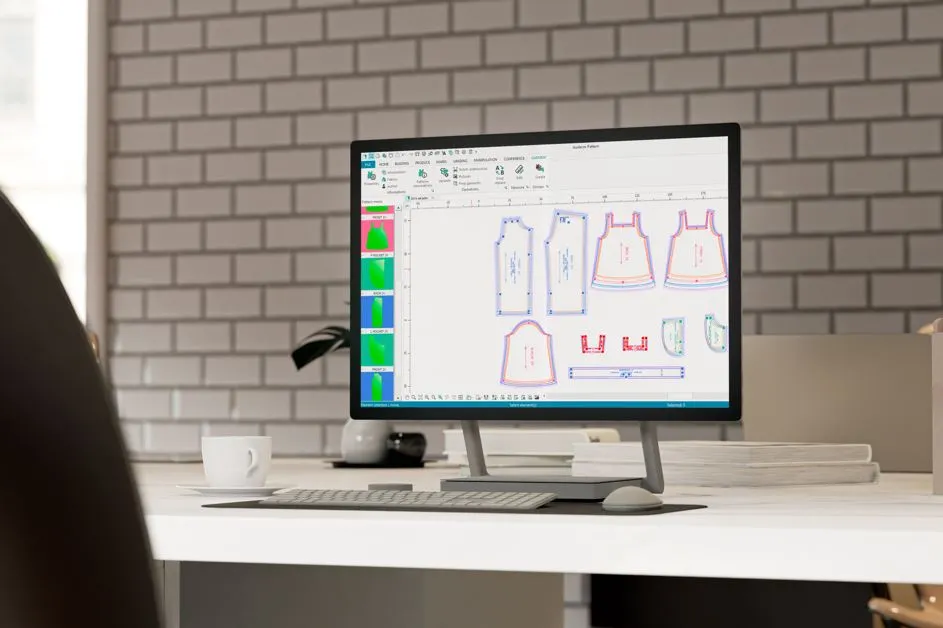
Pattern makers use the basic pants block to create trousers, shorts, and other lower-body garments. It starts from the waist and ends at the ankle, including darts and curves to match the hips and waist.
This block helps control the fit in key areas, like the waist, seat, and legs. It gives room to move but keeps the shape clean.
From the basic pants block, you can make many garments by changing the width, length, or rise. It’s a strong and necessary base for both casual and formal pants.
Basic sleeve block
The sleeve block is supposed to match the armhole of the bodice block. It usually has a smooth, rounded shape at the top, which fits into the armhole curve.
Sleeves can be short, long, wide, or narrow and the basic block helps you shape all types. You can add volume or make them tighter, depending on the style.
A well-made sleeve block ensures comfort and good movement. It’s key to creating balanced and well-fitting garments.
Learn more: 7 reasons to go digital with your handmade pattern
Basic skirt block
It is a simple shape that starts at the waist and ends below the hip or knee, with darts to fit the waist and hips smoothly.
Pattern makers use it to create many styles, like A-line, pencil, or flared skirts. You only need to change the shape, length, or volume.
This block is also part of the lower part of dresses. That’s why it’s important to build it well and fit it to the body carefully.
Learn more: How to create your own digital skirt pattern in 5 steps
Basic dress block
The dress block combines the bodice and skirt blocks into one pattern. It fits the body from shoulder to knee or below.
Using this block helps pattern makers design dresses quickly and with balance. Since the skirt and bodice are already together, it saves time and ensures the proportions are correct.
Because the dress block includes parts of the bodice and skirt, it’s flexible. You can create many dress styles by adjusting the neckline, waist, or skirt shape.
Starting any kind of pattern making work? You can rely on Audaces. This ebook dives into solutions for the biggest challenges in the area. Grab your free download right now!
Key steps in the pattern development process
Pattern makers follow a clear process that goes from the basic block to the cutting pattern. Now, let’s explore each step.
Basic block
The basic block is the starting point of any pattern. It is a simple shape made to fit the body, using measurements from the tech pack.
This pattern shows where the bust, waist, and hips are. It also marks the shoulder, neckline, and armholes, points that help guide the design.
Once the block is ready, you can copy it and change it. This is the basis for many different garments, and when well-made, saves time and avoids mistakes later.
Learn more: What is pattern design and how to create it from scratch?
Interpreted (or working) pattern
The interpreted pattern comes after the basic block. In this step, you must change the pattern to match the design. It’s time to style lines, shape, and add volume.
This is where the creative part happens. The working pattern may include pleats, gathers, or different cuts. Sometimes, it’s even based on an existing garment for reference.
Then, test and adjust the version. It’s not the final pattern yet, but it gives a clear idea of how the garment will look. Changes are easy to make at this stage.
Cutting pattern
The cutting pattern is the final step. It is the version used to cut fabric. All parts are ready, marked, and true to size.
This pattern includes seam allowances, grain lines, notches, and labels. These marks help guide sewing and assembly.
The cutting pattern must be very accurate, any mistake here can affect the whole garment. Once ready, it can go to the cutting table or be saved for future use.
How do body measurements influence flat pattern making?
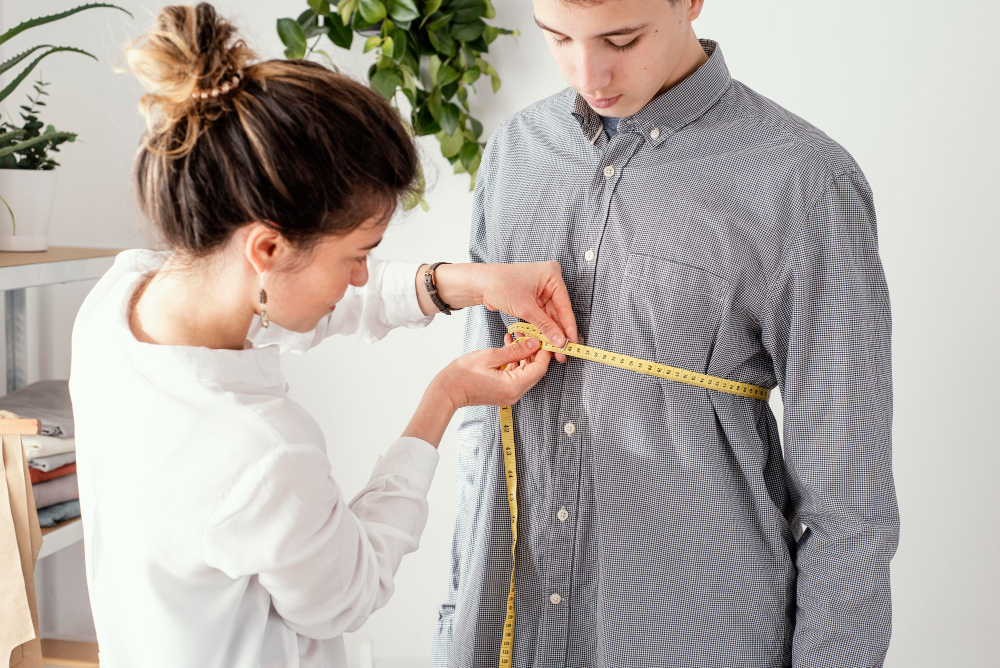
Without the right measurements, even the best design won’t work as planned. That’s why pattern makers must use key points on the body to create each block.
The most common measurements are bust, waist, and hips. However, depending on the garment and the number of details, you might need to add measurements from other areas.
These numbers decide the shape and size of the pattern. If the measurements are wrong, the garment will not fit properly. Even a small change in one area, like the waist or armhole, can affect the whole fit.
It’s crucial for a pattern maker to precisely follow the person’s measurements for custom garments. And in mass production, strict adherence to the tech pack and perfect size grading are essential.
What are the essential tools for pattern drafting and cutting?
To create good patterns, you need the right tools. They help pattern makers work faster, avoid errors, and get better results.
Today, many of them are digital, which brings even more speed and precision to your work.
Pattern digitizer
Sometimes patterns are still made by hand. When you have a pattern on paper, it’s important to save it as a digital file. This helps you store, share, and reuse your work.
A pattern digitizer lets you turn paper patterns into digital ones. It captures every shape and line with great accuracy, so you don’t need to draw them again on the computer.
With Audaces Digiflash, this process is fast and simple. You place your paper pattern, take a photo, and the software creates a clean digital version.
2D pattern making software
Creating patterns directly on the computer is now easier than ever. With 2D software, you can draw, change, and grade patterns without paper.
Audaces Pattern is a CAD software made for this. It has tools that help you create patterns step by step. You can also use it to make changes fast and apply automatic size grading.
This saves time, especially if you work with many sizes. It also helps avoid mistakes caused by manual work. You can test, adjust, and check details on the screen before sending anything to cut.
Using this software makes your process more professional. It’s a smart way to manage your patterns and grow your production.
3D simulation software
Before cutting fabric, it’s helpful to test how a pattern will look. 3D simulation shows the fit, shape, and style. This way, you can fix problems before making a real sample.
Audaces 3D brings your digital patterns to life on a 3D mannequin. You can simulate sews, folds, and movement, giving a full view of how the final piece will behave. It saves time, fabric, and effort.
Learn more: 5 reasons why pattern makers should start using 3D pattern
Marker making software
Once your pattern is ready, the next step is fabric layout. This is where marker making software helps. It places each piece of the pattern on the fabric in the best way.
Audaces Marker does this with intelligent tools. It finds the best layout to save fabric and reduce waste. The software also helps keep quality in the cutting stage.
Using it means more savings and better planning. You can cut more pieces with less fabric—and do it faster!
Automatic marker coprocessor
If you handle many markers, you need extra help. An automatic coprocessor boosts the power of your system. It helps create markers and keeps your station free to do other work.
Audaces Supera does exactly that. It enhances the quality of your marker layouts using smart calculations. It also organizes your marker queue, so your main workstation stays clear.
Create and simulate your patterns with Audaces360 multi-solution
Audaces360 integrates cutting-edge digital innovations to optimize workflows in the textile and apparel industry.
It caters to companies of all sizes and types, offering the flexibility to scale with your business needs.
All solutions were carefully developed to address the specific challenges of the field. They streamline the design and production processes, saving valuable time and resources.
The platform boasts a comprehensive range of functionalities, including pattern making, marking, collection management, vector drawing, and 3D creation.
In addition, a fashion Artificial Intelligence to assist you along the way.
Discover Audaces360 and unlock a world of possibilities for fashion design and production. Explore our comprehensive suite of solutions today!
FAQ
Flat pattern making is one of the most important parts of creating clothes. It helps turn a sketch or idea into a real garment. Without it, fashion would not be so precise or professional.
Flat pattern making is the process of creating clothing patterns on a flat surface. These patterns are useful to cut fabric and sew garments, starting from a set of body measurements included in the tech pack.
Pattern digitizer, 2D pattern making software, 3D simulation, marker making, and automatic marker coprocessor.


